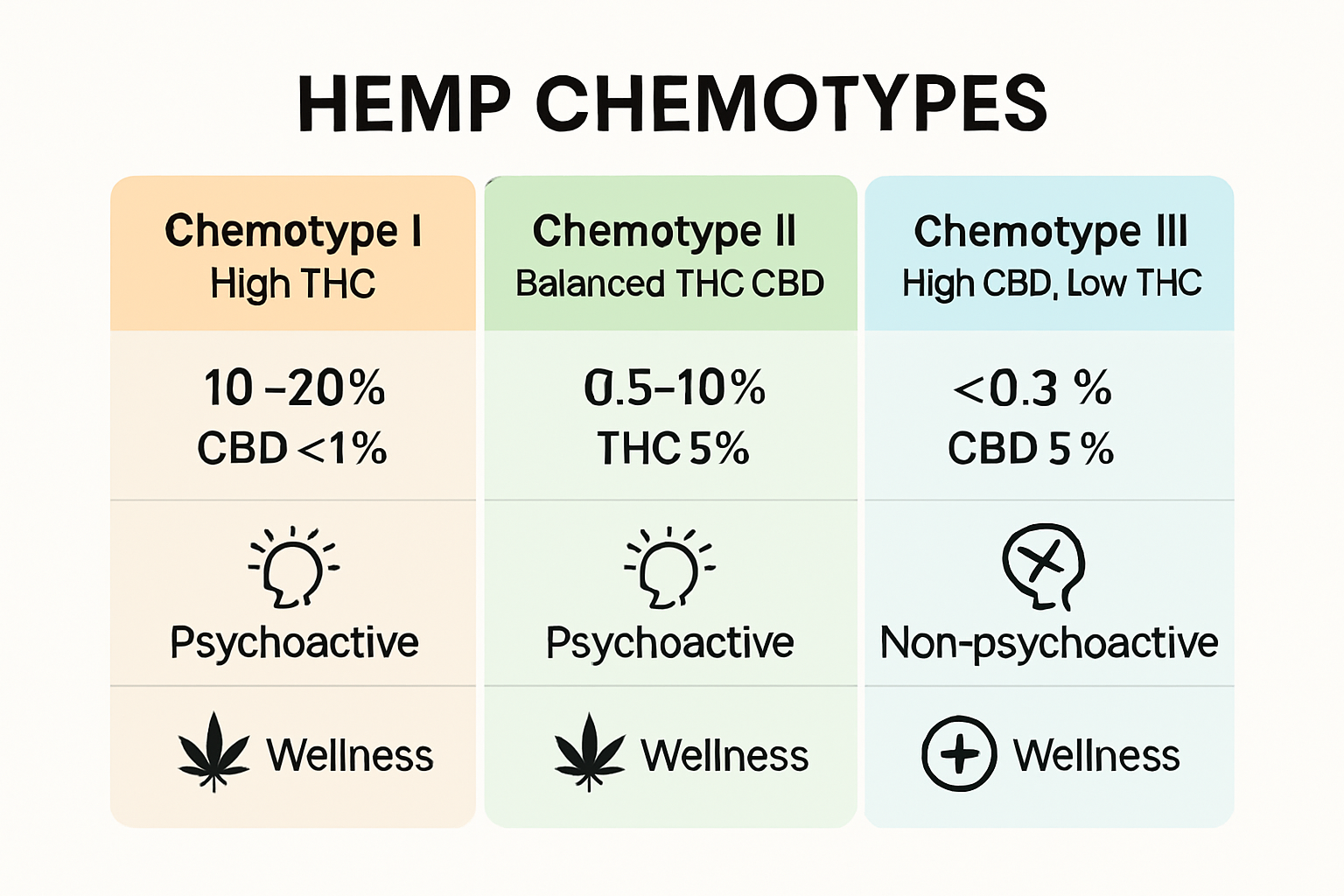Key Differences in Hemp Strains for Wellness and Relief
Written by California Blendz
Hemp strains are taking the wellness world by storm and people are buzzing about their therapeutic promise for pain relief, stress, and sleep. Some think all hemp is basically the same and any strain will do the job. That is where most folks get it wrong because research shows there are three main chemotypes of hemp and each has drastically different effects on the body. The gap between strains can mean the difference between true relief and wasted time so let’s see why your choice matters more than you think.
Table of Contents
- Understanding Hemp Strain Categories
- Popular Cannabinoids And Their Effects
- Choosing The Right Hemp Strain For Your Needs
- Smokable Hemp Flower Vs Extracts
Quick Summary
| Takeaway | Explanation |
|---|---|
| Understand Hemp Strain Categories | Hemp strains vary based on cannabinoid content and therapeutic functions. Know their classification to choose wisely. |
| Identify Desired Effects for Strain Selection | Select strains based on specific wellness goals like pain relief or anxiety. Tailor your choice to your needs. |
| Recognize Individual Response Variability | Personal physiology greatly influences how hemp strains affect you. Monitor your reactions for better outcomes. |
| Consider Consumption Methods Effectively | Smoking offers quick effects while extracts may provide precise dosing. Choose based on your wellness preferences. |
| Consult Healthcare Professionals | Professional guidance is crucial when choosing hemp strains for wellness. Individual recommendations can promote safety and efficacy. |
Understanding Hemp Strain Categories
Hemp strains represent a complex botanical landscape with nuanced differences that significantly impact wellness and relief potential. The scientific classification of hemp goes far beyond simple categorization, involving intricate genetic profiles and cannabinoid compositions that determine their therapeutic characteristics.
Cannabinoid Chemotype Classification
Researchers have developed a sophisticated system for classifying hemp strains based on their cannabinoid content. According to scientific research by Fernandez et al., cannabis sativa plants can be divided into three primary chemotypes:
- Chemotype I: Predominantly high in THC, typically associated with more psychoactive properties
- Chemotype II: Balanced THC and CBD content, offering intermediate effects
- Chemotype III: High in CBD with minimal THC, focused on therapeutic benefits without psychoactive impact
This classification system provides crucial insights into how different hemp strains interact with the human body. Research published in recent cannabinoid studies demonstrates that these chemotypes are genetically determined, meaning the cannabinoid concentration is inherent to the plant’s genetic makeup.
To better understand the differences between the three main cannabinoid chemotypes of hemp, the following table summarizes their cannabinoid content and associated effects:
| Chemotype | Dominant Cannabinoid(s) | THC Content | CBD Content | Typical Effects |
|---|---|---|---|---|
| Chemotype I | THC | High | Low | Psychoactive, potential for pain relief, appetite |
| Chemotype II | THC & CBD (Balanced) | Medium | Medium | Intermediate effects, mild psychoactivity |
| Chemotype III | CBD | Low | High | Non-psychoactive, focus on therapeutic benefits |

Functional Strain Characteristics
Beyond chemotype classification, hemp strains are further distinguished by their intended therapeutic functions. Some strains are engineered for specific wellness goals such as stress reduction, pain management, or sleep improvement. The combination of cannabinoids and terpenes creates what experts call the “entourage effect” - a synergistic interaction that enhances overall therapeutic potential.
Interestingly, not all hemp strains are created equal. Factors like growing conditions, harvesting techniques, and genetic lineage play significant roles in determining a strain’s final chemical profile. Want to dive deeper into selecting the right hemp strain? Check out our comprehensive guide to choosing hemp strains.
The complexity of hemp strain categories reflects the plant’s remarkable adaptability and potential. From industrial hemp with minimal cannabinoid content to carefully cultivated therapeutic varieties, each strain represents a unique combination of genetic potential and environmental influence. Understanding these nuanced differences empowers consumers to make informed choices about their wellness journey, selecting strains that align precisely with their individual health and relief needs.
Popular Cannabinoids and Their Effects
Cannabinoids represent a fascinating group of chemical compounds that interact with the human body’s endocannabinoid system, offering diverse potential wellness benefits. Each cannabinoid possesses unique properties that contribute to a complex therapeutic landscape beyond simple symptom management.
Primary Cannabinoids and Their Therapeutic Potential
The cannabis plant produces numerous cannabinoids, with some standing out for their remarkable health interactions. Research from the National Institutes of Health highlights the distinctive characteristics of key cannabinoids:
-
Cannabidiol (CBD): A non-intoxicating compound known for potential anxiety reduction and anti-inflammatory properties. Interestingly, CBD interferes with anandamide deactivation and acts as an agonist for serotonin receptors, which may contribute to its neurological benefits.
-
Cannabichromene (CBC): A non-psychoactive cannabinoid demonstrating promising antimicrobial and analgesic properties. CBC interacts uniquely with the endocannabinoid system, potentially offering alternative therapeutic approaches.
-
Tetrahydrocannabinol (THC): The primary psychoactive compound associated with potential pain management and appetite stimulation, though its effects are more complex than traditional understanding suggests.
Cannabinoid Interaction and Synergy
Cannabinoids do not work in isolation but interact through what experts call the “entourage effect”. Learn more about the synergistic benefits of cannabinoid interactions, where multiple compounds amplify each other’s therapeutic potential.
The complexity of cannabinoid interactions extends beyond simple receptor activation. Each compound contributes unique molecular interactions that can modulate pain perception, inflammatory responses, and neurological function. This intricate interplay suggests that whole-plant extracts might offer more comprehensive benefits compared to isolated cannabinoids.
Researchers continue exploring how different cannabinoids communicate within the human body, uncovering nuanced mechanisms that challenge traditional medical paradigms. The emerging understanding suggests cannabinoids are not just passive compounds but active participants in complex physiological conversations.
While scientific research continues to evolve, the potential of cannabinoids for wellness remains a compelling frontier of medical exploration. Individual responses can vary significantly, highlighting the importance of personalized approaches and professional medical guidance when considering cannabinoid-based wellness strategies.
Choosing the Right Hemp Strain for Your Needs
Selecting the ideal hemp strain requires a thoughtful approach that considers individual wellness goals, physiological responses, and specific health requirements. The process goes beyond simple product selection and involves understanding personal health objectives and the nuanced characteristics of different hemp varieties.
Strain Selection Based on Desired Effects
Research from medical cannabis surveys reveals fascinating insights into strain preferences for specific conditions. Different strains demonstrate varying effectiveness for managing particular symptoms:
-
Indica Strains: Typically recommended for sleep disorders and pain relief. Strains like Mother of Berries (M.O.B.) have shown remarkable potential in addressing chronic pain and sleep disruptions.
-
Hybrid Strains: Offer balanced effects, making them versatile for individuals seeking moderate symptom management. Some hybrid varieties are particularly effective for managing anxiety and PTSD symptoms.
-
Sativa Strains: Generally associated with potential mood elevation and energy enhancement, though individual responses can vary significantly.
Understanding Individual Response Variability
Scientific studies examining patient outcomes highlight a critical aspect of hemp strain selection: individual physiological differences dramatically impact therapeutic responses. Cannabis flower products demonstrate more consistent symptom relief compared to other consumption methods, with higher THC content correlating with improved symptom management.
Interested in diving deeper into strain selection? Check out our comprehensive guide to top CBD hemp strains to help refine your selection process.
A 2024 medical analysis of 600 patient records uncovered intriguing patterns in strain effectiveness. Research published in recent medical journals indicated that Cannabis indica strains demonstrated superior pain relief capabilities. Notably, high THC/low CBD strains were associated with increased appetite but also potential increases in anxiety levels.
When choosing a hemp strain, consider these critical factors:
- Your specific wellness objectives
- Potential interaction with existing medications
- Personal tolerance and sensitivity
- Desired onset and duration of effects
Consultation with healthcare professionals remains paramount. While hemp strains offer promising wellness potential, they are not universal solutions. Each individual’s endocannabinoid system responds uniquely, making personalized guidance essential.
The journey of finding the perfect hemp strain is deeply personal. It requires patience, self-awareness, and a willingness to experiment responsibly. By understanding the nuanced differences between strains and listening to your body’s responses, you can discover a hemp variety that genuinely supports your wellness goals.
Smokable Hemp Flower vs Extracts
The world of hemp consumption offers diverse methods, each with unique characteristics, absorption rates, and potential benefits. Understanding the fundamental differences between smokable hemp flower and extracts can help consumers make informed decisions aligned with their wellness goals.
Consumption Method Dynamics
Research examining cannabis product differentiation highlights critical distinctions between hemp varieties. Hemp, defined as non-intoxicating Cannabis sativa L. with low delta-9 THC levels, can be consumed through various methods, each offering distinct physiological interactions.
Smokable hemp flower provides an immediate, full-spectrum experience. When inhaled, cannabinoids enter the bloodstream rapidly through lung absorption, offering quick onset of potential therapeutic effects. Clinical studies on medical cannabis products indicate that inhaled cannabis can provide short-term relief, particularly for chronic neuropathic pain conditions.
Comparative Analysis of Absorption and Efficacy
Extracts, including oils, tinctures, and concentrates, present a different consumption profile. These products undergo processing to concentrate specific cannabinoids, potentially offering more precise dosage control. Comprehensive medical reviews suggest that cannabinoid-based medicines can alleviate certain pain conditions, though efficacy varies depending on individual physiology and product composition.
Want to explore the nuances of hemp flower in more depth? Learn about CBD flower and its unique characteristics.
Key differences between smokable hemp flower and extracts include:
Here’s a table that compares the key features, benefits, and considerations of smokable hemp flower and extracts for wellness consumers:
| Method | Onset Speed | Dosage Precision | Cannabinoid/Terpene Profile | Convenience |
|---|---|---|---|---|
| Smokable Hemp Flower | Fast | Low | Full (Entourage Effect) | Less portable |
| Extracts (Oils/etc.) | Moderate-Slow | High | Variable/Targeted Profile | More portable/discreet |
- Absorption Speed: Smoking provides near-instantaneous effects, while extracts might have delayed or prolonged absorption
- Cannabinoid Preservation: Whole flower maintains the natural terpene and cannabinoid profile
- Dosage Precision: Extracts often allow more exact dosage measurement
- Convenience: Extracts are typically more portable and discreet
Important considerations emerge when comparing these consumption methods. Smokable hemp flower offers a more holistic experience, preserving the plant’s natural chemical complexity. Extracts, conversely, provide a more refined, targeted approach to cannabinoid consumption.
Medical research indicates mild to moderate side effects can occur with cannabinoid consumption, emphasizing the importance of responsible use and professional medical guidance. While both smokable flower and extracts present potential wellness benefits, individual responses can vary significantly.
Ultimately, the choice between smokable hemp flower and extracts depends on personal preferences, health objectives, and individual physiological responses. Consulting healthcare professionals can provide personalized insights into the most suitable consumption method for specific wellness needs.
Frequently Asked Questions
What are the main types of hemp strains?
Hemp strains can be classified into three main chemotypes: Chemotype I (high in THC), Chemotype II (balanced THC and CBD), and Chemotype III (high in CBD with minimal THC). Each type has different therapeutic effects.
How do I choose the right hemp strain for my wellness needs?
To choose the right hemp strain, consider your specific wellness goals, such as pain relief, anxiety reduction, or sleep improvement, and select a strain that aligns with those objectives.
What is the entourage effect in hemp strains?
The entourage effect refers to the synergistic interaction between various cannabinoids and terpenes in hemp, which can enhance the overall therapeutic potential of the strain beyond that of isolated compounds.
What are the differences between smokable hemp flower and extracts?
Smokable hemp flower offers fast effects and a full-spectrum profile, while extracts provide more precise dosage control and may have a delayed onset. The choice depends on personal preferences and health objectives.
Discover the Perfect Hemp Strain for Your Unique Journey
Struggling to navigate all the differences between hemp strains and find real relief? If you want therapeutic benefits without wasted effort, your choice of strain truly matters. At California Blendz, our Flower Collection brings you expertly curated CBD and THCa flowers, each with distinct cannabinoid profiles designed to support your wellness goals. We know how important it is to match strain effects and chemotypes with your personal needs, and we make it simple to find only lab-tested, premium products.

Experience the difference of shopping with full transparency and detailed educational support at California Blendz. Browse our selection today and unlock the relief and balance you have been searching for. Start now and take control of your hemp wellness journey.
Recommended
- The Top CBD Hemp Strains: A Comprehensive Guide to Choosing the Right – California Blendz
- Discover the Benefits of Relaxing Hemp Flower and How it Can Enhance Y – California Blendz
- Discover the Best Pain-Relief Cannabis Strains for Natural Relief and – California Blendz
- Discover the Top Soothing CBD Strains: A Guide to Relaxation and Welln – California Blendz








